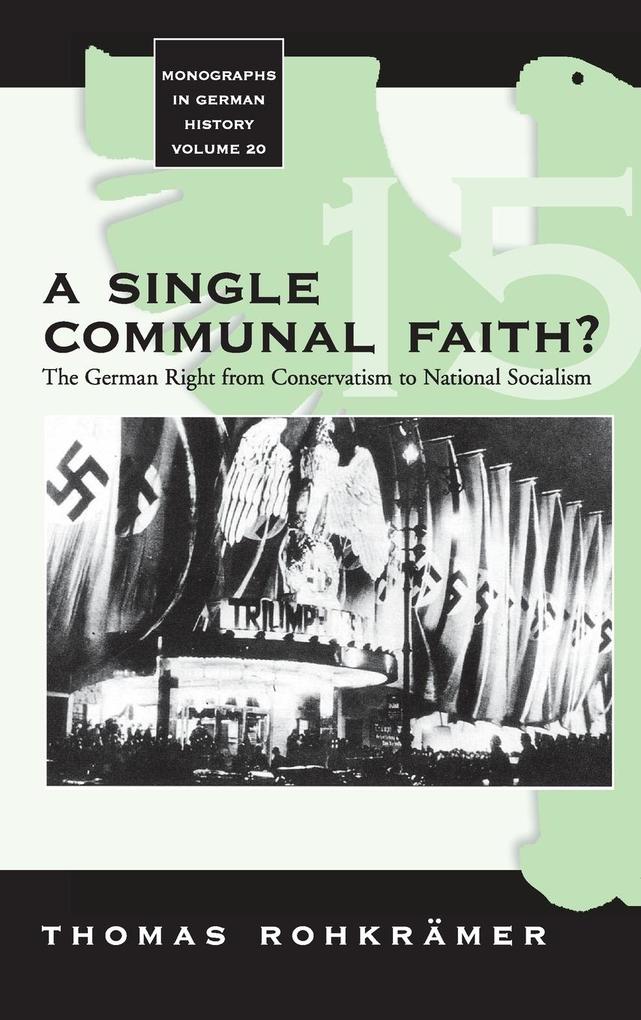
Zustellung: Mi, 16.07. - Sa, 19.07.
Versand in 7 Tagen
VersandkostenfreiBestellen & in Filiale abholen:
How could the Right transform itself from a politics of the nobility to a fatally attractive option for people from all parts of society? How could the Nazis gain a good third of the votes in free elections and remain popular far into their rule? A number of studies from the 1960s have dealt with the issue, in particular the works by George Mosse and Fritz Stern. Their central arguments are still challenging, but a large number of more specific studies allow today for a much more complex argument, which also takes account of changes in our understanding of German history in general. This book shows that between 1800 and 1945 the fundamentalist desire for a single communal faith played a crucial role in the radicalization of Germany's political Right. A nationalist faith could gain wider appeal, because people were searching for a sense of identity and belonging, a mental map for the modern world and metaphysical security.
Inhaltsverzeichnis
Preface
Introduction
Chapter 1. Prelude: The Weakening of Tradition and the Search for a New Faith in the Early Nineteenth Century
Chapter 2. From Left to Right: The Emergence of a Right-Wing Nationalist Faith
Chapter 3. Visions of a Spiritual Unification in the German Empire
Chapter 4. A Single Communal Faith through War? The First World War as a Watershed
Chapter 5. Playing with Fire: The Right in the Weimar Republic
The Conservative Revolution and the Ideal of a Single Communal Faith
Chapter 6. Nazism and the Creation of a Communal World-View
Nazism and the Idea of a Single Communal Faith
Rituals and Visions
A Reconciliation of Nature and Technology
The Vision of a Harmonious Community of the People (Volksgemeinschaft)
The Rhetorics of Heroism and a Grand Reich
Conclusion
Select Bibliography
Index
Introduction
Chapter 1. Prelude: The Weakening of Tradition and the Search for a New Faith in the Early Nineteenth Century
Chapter 2. From Left to Right: The Emergence of a Right-Wing Nationalist Faith
Chapter 3. Visions of a Spiritual Unification in the German Empire
Chapter 4. A Single Communal Faith through War? The First World War as a Watershed
Chapter 5. Playing with Fire: The Right in the Weimar Republic
The Conservative Revolution and the Ideal of a Single Communal Faith
Chapter 6. Nazism and the Creation of a Communal World-View
Nazism and the Idea of a Single Communal Faith
Rituals and Visions
A Reconciliation of Nature and Technology
The Vision of a Harmonious Community of the People (Volksgemeinschaft)
The Rhetorics of Heroism and a Grand Reich
Conclusion
Select Bibliography
Index
Mehr aus dieser Reihe
Produktdetails
Erscheinungsdatum
01. Oktober 2007
Sprache
englisch
Seitenanzahl
308
Reihe
Monographs in German History, 20
Autor/Autorin
Thomas Rohkrämer
Verlag/Hersteller
Produktart
gebunden
Gewicht
599 g
Größe (L/B/H)
235/157/21 mm
ISBN
9781845453688
Entdecken Sie mehr
Bewertungen
0 Bewertungen
Es wurden noch keine Bewertungen abgegeben. Schreiben Sie die erste Bewertung zu "A Single Communal Faith?" und helfen Sie damit anderen bei der Kaufentscheidung.































